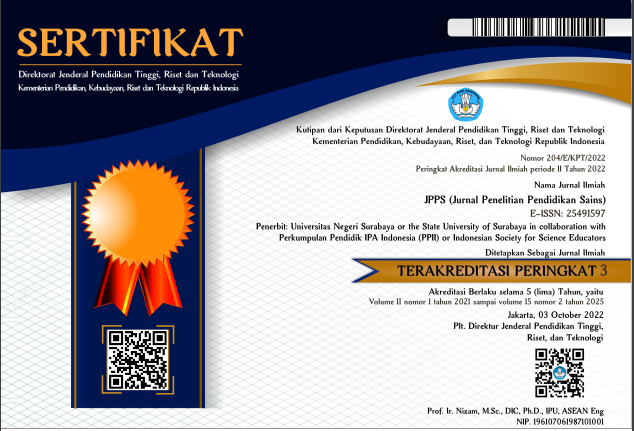Profile of Top 100 Cited in STEM Education for the Last Twenty Years
DOI:
https://doi.org/10.26740/jpps.v12n1.p69-84Keywords:
Bibliometric, STEM Education, Technology, Top 100 CitedAbstract
The research analyzes the top 100 cited publications in STEM education in the last twenty years. The research objectives are to analyze the publication type, year, sources publishing, authorship pattern, institution, country, and keywords pattern and review these top-cited publications using bibliometric analysis. The metadata used in this research is the Scopus database. The study result shows that among these top 100 publications, the most common type of publication is journal articles. Most of these publications were conducted at four-year intervals from 2014 to 2017, with an average citation per paper of 70.75. Belland is recognized as the most productive author, whereas National Research Council has become the institution with the most citations. The most contributed institutions included Purdue University and the University of Minnesota. The USA has led over highly cited publications, followed by Australia and the Netherlands. The research areas in these papers mainly emphasize education, STEM, STEM education, engineering education, and every stem aspect. The review result focus on research on the conceptual framework of STEM integration, STEM-based learning media, challenges to STEM, perspectives on STEM education, and the impact of Covid-19 on STEM education. This research implies finding research novelties about STEM education through the results of mapping and visualization patterns based on keywords that often appear.
Downloads
References
Connor, A. M., Karmokar, S., & Whittington, C. (2015). From STEM to STEAM: Strategies for enhancing engineering & technology education. International Journal of Engineering Pedagogy (IJEP), 5(2), 37. https://doi.org/10.3991/ijep.v5i2.4458
Guangfu, Q., Hu, W., Jiao, W., & Jin, J. (2021). Application of deep learning-based integrated trial-error + science, technology, reading/writing, engineer, arts, mathematics teaching mode in college entrepreneurship education. Frontiers in Psychology, 12, 739362. https://doi.org/https://doi.org/10.3389/fpsyg.2021.739362
Ha, C. T., Thao, T. T. P., Trung, N. T., Huong, L. T. T., Dinh, N. Van, & Trung, T. (2020). A bibliometric review of research on STEM education in ASEAN: Science mapping the literature in scopus database, 2000 to 2019. Eurasia Journal of Mathematics, Science and Technology Education, 16(10). https://doi.org/10.29333/ejmste/8500
Jatmiko, B., Prahani, B. K., Suprapto, N., Admoko, S., Deta, U. A., Lestari, N. A., Jauhariyah, M. N. R., Yantidewi, M., & Muliyati, D. (2021). Bibliometric analysis on online physics learning during COVID-19 Pandemic: Contribution to physics education undergraduate program. Journal of Physics: Conference Series, 2110(1), 1-7. https://doi.org/10.1088/1742-6596/2110/1/012018
Kelley, T. R., & Knowles, J. G. (2016). A conceptual framework for integrated STEM education. International Journal of STEM Education, 3(1). https://doi.org/10.1186/s40594-016-0046-z
National Researchs Council. (2011). Successful K-12 STEM education: Identifying effective approaches in science, technology, engineering, and mathematics. The National Academies Press.
Nawaz, S., & Strobel, J. (2016). Authorship and content analysis of engineering education research: A case study. International Journal of Engineering Pedagogy (IJEP), 6(2), 39. https://doi.org/10.3991/ijep.v6i2.5577
Widya, Rifandi, R., & Laila Rahmi, Y. (2019). STEM education to fulfil the 21st century demand: A literature review. Journal of Physics: Conference Series, 1317(1). https://doi.org/10.1088/1742-6596/1317/1/012208
Downloads
Published
How to Cite
Issue
Section
License
Copyright (c) 2022 JPPS (Jurnal Penelitian Pendidikan Sains)

This work is licensed under a Creative Commons Attribution-ShareAlike 4.0 International License.
 Abstract views: 583
,
Abstract views: 583
, PDF Downloads: 341
PDF Downloads: 341












